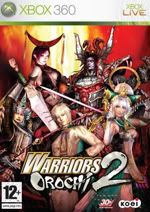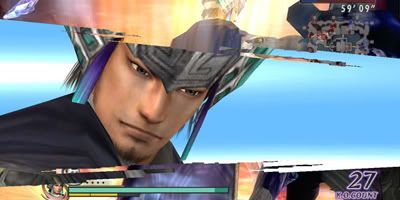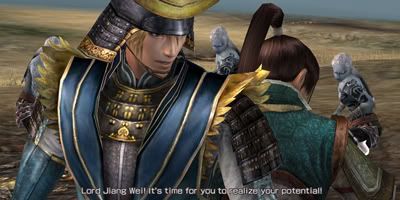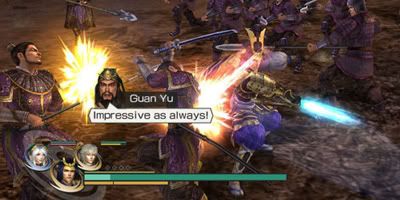Warriors Orochi 2 – Xbox 360
 Review by Johnus Maximus
Review by Johnus Maximus
Warriors Orochi 2 is the follow up to last years crossover between two of Koei’s best selling hack and slash franchises – Dynasty Warriors and Samurai Warriors. Released in September 2008, it is also available for PS2 and soon the PSP.
Developed by Omega Force and published by Koei the game seems to take a step forward in offering the player more characters and levels, yet also manages to take a step backward in terms of playability and technical competence, enough to frustrate even a die-hard Warriors fan.
In the last title, the serpent king Orochi created a rift in space and time which dragged some of Asia’s greatest warriors into a strange dimension. Forced to forge unlikely alliances the warriors were able to defeat their evil overlord and bring peace to the land. Peace doesn’t last for long though and just like in a dodgy horror movie sequel the villain doesn’t stay dead for long either, being resurrected by his underlings and determined more than ever to destroy his enemies.
It’s a fairly throwaway plot but is actually a new story, rather than just a rehash of the same stories which is what the other Warriors games tend to do. The primary mode you’ll play is the Story Mode, in which you are able to follow the course of the game from the perspective of the Chinese armies of Wu, Shu and Wei, and also the Japanese Samurai. Additionally you can opt to play as the bad guys right from the get go as the Orochi army lies at your command, not following the new storyline, but rather in a precursor to the events of the previous game.
The way you play the game remains the same as the last title, you select a team of three warriors and venture onto a battlefield with hordes of enemies that are waiting to stop you from completing your objectives. Dispatching of these enemies is straightforward, you have to mash the attack buttons until they’re all gone. At any time you can switch to one of the other two warriors, which is great when you are low on health or want to perform a devastating Musou attack to kill many enemies at once.

A dramatic anime-style moment when activating a musou move
The levels all look fairly similar to the last game which is still disappointing as Koei could really capitalise more on the opportunity for merging fantastical, alien looking landscapes alongside the staple castles, forests and boats that we see in the regular Warriors games. They have improved slightly with the generic enemy officers, as they have added some new ones which fit in with the other worldly scenario – there’s a sinister looking demonic ninja and a huge boar-like monstrosity.
It will come as no surprise to those who have played any of the previous Warriors games that the approach you’ll end up taking in this one is to run about killing hundreds of weak foot soldiers, kill a few strong generals, capture some bases and then complete your goals. All a bit samey but that’s pretty much the overall idea of these hack n slash type games.
As you progress through the story you find more warriors to join your ranks, which allows you some freedom of choice in the type of characters you select and given the large roster you can easily ignore the ones you don’t like playing with. The number of characters in the game is immense, there are thirteen more than the previous game taking the tally up to ninety-two playable characters. Some of them have never been seen before in the Warriors games, my favourite being Sun Wukong, or as some people may know him – Monkey!

Jiang Wei managed it, but the game didn’t.
If you get tired of playing the story mode you can also opt to play the Free Mode, in which you can play any unlocked level with any set of unlocked characters at a variety of skill levels. There is also a Dream Mode, which is now a standalone feature rather than being tagged onto the main story mode. In Dream Mode there are twenty-eight separate stages and each one has a special scenario, objective and set of characters that you must use to complete it.
The Story, Free and Dream modes are all available to play in both single player and co-operative (not via Xbox Live) but be aware that adding another player will split the screen so it’s harder to see things and also present a greater opportunity for graphical slowdown. That’s right, one of the most pertinent negative factors that struck the previous Orochi title was graphical slowdown when large volumes of enemies were on or near the screen, and it’s present again in this iteration.
Now I’m not a games developer, nor do I get the opportunity to playtest and give feedback on things like this, but I’m sure that I’m not the only person who thinks this is unreasonable. Perhaps it was of an acceptable level to the developers, but I hated it and it really worsened the game experience. The severity of the slowdown does vary from level to level, but is present throughout the game. I challenge anyone to play “The battle of Chi Bi” without wanting to pull your hair out.
(NOTE – Between writing and publishing this review a patch has been made available on Xbox Live to fix the slowdown issues. I can report that it does improve the problem, but doesn’t eliminate it entirely.)

Kill enough enemies and you get nice compliments from allies
As well as the co-operative option in the main game modes there are a few small two player versus modes that allow you and a friend to go head to head against four different challenges. Tag Team sees you both fighting to the death against each other with your team of three warriors. Elimination is the same but with just one character. In Tower you have to try to knock your opponent to the ground below and finally in Steeple Chase you get to compete in a horse race.
Whilst they serve as good distractions they don’t add a lot of value to the core game element, if you want a proper fighting game you should opt for something like Soul Calibur IV. I think that rather than introducing these features Omega Force could have better spent the development time incorporating some of the advancements that were made in their most recent title – Dynasty Warriors 6 – most importantly the Renbu unlimited combo system, and also the graphical improvements.
It’s for these reasons that I am disappointed with the game, as it really feels like more of an expansion to the original than a sequel, Warriors Orochi 1.5 if you will. Although I’m a seasoned Warriors fan, and appreciate the massive range of playable characters and levels, I really think so much more could have been achieved here if a little more time had been spent on ironing out the flaws of the previous title and incorporating the advancements I mention above.
This is really only a must-have purchase for the most forgiving die hard fans. If you’re not one of those but you’re looking to get a game like this you could certainly fare better with some of Koei’s other titles, for example Dynasty Warriors 6 and the medieval battle game Bladestorm.
Warriors Orochi 2 scores two and a half ninja stars out of five
